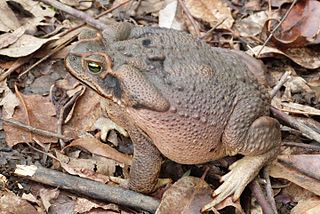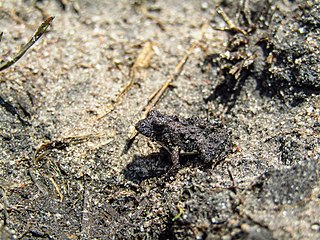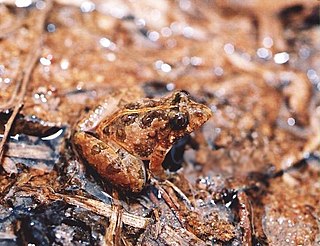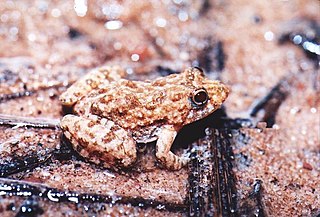
Pseudopaludicola is a genus of leptodactylid frogs from lowland northern and central South America. They are known under the common name dwarf swamp frogs or swamp frogs.

The wallum sedge frog, also known as the Olongburra frog or the sharp-snouted reed frog, is a species of frog that is endemic to Australia. Varying in color from brown to dark green it inhabits the thick and often acidic marshes of the Wallum along the coast of Queensland and New South Wales. Mating season comes in early spring, often after heavy rainfalls. Females attach their eggs to grasses and sedges. Their call is high pitched and follows a "creeeek... crik" pattern.

Rhinella diptycha, sometimes referred to as Cope's toad, Schneider's toad, cururu toad, or rococo toad, is a toad found in northern Argentina, Paraguay, Uruguay, eastern Bolivia, and eastern and southern Brazil.
The Nyonga forest tree frog is a species of frog in the family Arthroleptidae endemic to the Democratic Republic of the Congo. Its natural habitats are rivers, freshwater marshes, and intermittent freshwater marshes. As of 2004, the Upemba National Park was the only place in which they were being protected.

Pseudopaludicola boliviana is a species of frog in the family Leptodactylidae. It is found in Argentina, Bolivia, Brazil, Colombia, Guyana, Paraguay, Suriname, and Venezuela. Its natural habitats are subtropical or tropical dry forests, subtropical or tropical moist lowland forests, moist savanna, subtropical or tropical seasonally wet or flooded lowland grassland, swamps, freshwater marshes, intermittent freshwater marshes, pastureland, ponds, irrigated land, and seasonally flooded agricultural land.
Pseudopaludicola ceratophyes is a species of frog in the family Leptodactylidae. Common name Leticia swamp frog has been coined for it, after its type locality, Leticia in Amazonas, Colombia. It is found in extreme southernmost Colombia, northeastern Peru, and adjacent western Brazil.
Pseudopaludicola mineira is a species of frog in the family Leptodactylidae. It is endemic to Brazil. Its natural habitats are moist savanna, subtropical or tropical moist shrubland, subtropical or tropical seasonally wet or flooded lowland grassland, subtropical or tropical high-altitude grassland, intermittent freshwater marshes, and pastureland. It is threatened by habitat loss.

Pseudopaludicola mystacalis is a species of frog in the family Leptodactylidae. It is found in Argentina, Bolivia, Brazil, Paraguay, and possibly Uruguay. Its natural habitats are moist savanna, subtropical or tropical moist shrubland, subtropical or tropical seasonally wet or flooded lowland grassland, freshwater marshes, intermittent freshwater marshes, pastureland, and seasonally flooded agricultural land. It is threatened by habitat loss.

Pseudopaludicola saltica, also known as the Chupada swamp frog or long-legged swamp froglet , is a species of frog in the family Leptodactylidae. It is endemic to south-central Brazil.

Pseudopaludicola ternetzi is a species of frog in the family Leptodactylidae. It is endemic to Brazil. Its natural habitats are moist savanna, subtropical or tropical moist shrubland, subtropical or tropical seasonally wet or flooded lowland grassland, swamps, moist montane forests, intermittent freshwater marshes, pastureland, ponds, and seasonally flooded agricultural land. It is threatened by habitat loss.
The false western froglet is a species of frog in the family Myobatrachidae. It is endemic to Australia. Its natural habitats are temperate forests, rivers, intermittent rivers, shrub-dominated wetlands, swamps, freshwater lakes, intermittent freshwater lakes, freshwater marshes, intermittent freshwater marshes, freshwater springs, rocky areas, arable land, pastureland, plantations, water storage areas, ponds, open excavations, wastewater treatment areas, seasonally flooded agricultural land, and canals and ditches. It is threatened by habitat loss.
The small western froglet is a species of frog in the family Myobatrachidae. It is endemic to Australia. Its natural habitats are temperate forests, subtropical or tropical seasonally wet or flooded lowland grassland, swamps, freshwater lakes, intermittent freshwater lakes, freshwater marshes, and intermittent freshwater marshes. It is threatened by habitat loss.

The orange-crowned toadlet, or western toadlet, is a species of frog in the family Myobatrachidae. It is endemic to Australia. Its natural habitats are temperate shrubland, Mediterranean-type shrubby vegetation, intermittent rivers, intermittent freshwater lakes, freshwater marshes, intermittent freshwater marshes, and rocky areas.

The green puddle frog, rough-skinned floating frog, pearly skin puddle frog, or pointed-tongued floating frog is a species of frog in the family Dicroglossidae. It is found in Bangladesh, Cambodia, China, Hong Kong, India, Indonesia, Laos, Malaysia, Myanmar, Thailand, Vietnam, and possibly Nepal.

The Mascarene grass frog, or Mascarene ridged frog, is a species of frog in the family Ptychadenidae. It is found in sub-Saharan Africa, Madagascar, and Mauritius.

The Central Asiatic frog, or Asian frog, is a species of true frog, found in China, Kazakhstan, and Kyrgyzstan. Its natural habitats are temperate forests, temperate shrubland, temperate grassland, rivers, intermittent rivers, swamps, freshwater lakes, intermittent freshwater lakes, freshwater marshes, intermittent freshwater marshes, freshwater springs, inland deltas, arable land, pastureland, rural gardens, urban areas, water storage areas, ponds, aquaculture ponds, and irrigated land. It is not considered threatened by the IUCN.

The Hokkaidō frog or the Ezo brown frog is a species in the family Ranidae found in Hokkaidō, Japan, and Sakhalin, Russia. Its natural habitats are boreal forests, temperate forests, temperate shrubland, temperate grassland, rivers, swamps, intermittent freshwater lakes, freshwater marshes, intermittent freshwater marshes, arable land, ponds, and irrigated land.

Vaillant's frog is a species of frog in the family Ranidae found in Central America. Its natural habitats are subtropical or tropical dry forests, subtropical or tropical moist lowland forests, subtropical or tropical swamps, rivers, swamps, freshwater lakes, intermittent freshwater lakes, freshwater marshes, intermittent freshwater marshes, rural gardens, heavily degraded former forests, water storage areas, ponds, and canals and ditches.

Pseudopaludicola falcipes is a species of frog in the family Leptodactylidae. It is found in the Pampas of northeastern Argentina, Uruguay, and southern Brazil.














